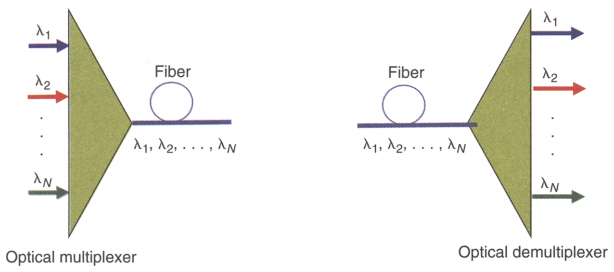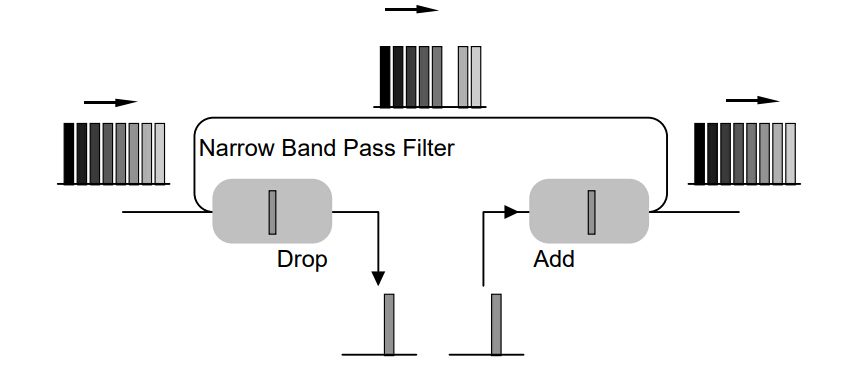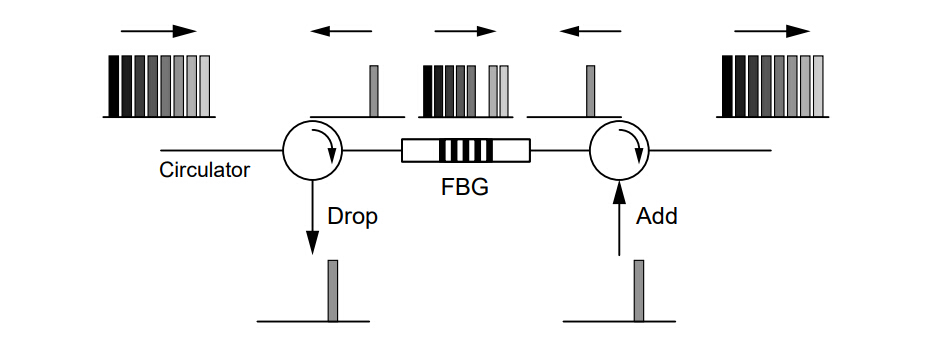OADM (Optical Add-Drop Multiplexer) Introduction
The enormous growth in the demand for bandwidth is pushing the utilization of fiber infrastructures to their limits. To fulfill this requirement, optical add-drop multiplexers (OADMs) were introduced in metro/access networks, serving as the simplest elements to introduce wavelength management capabilities by enabling the selective add and drop of optical channels. Since the OADM is based on low-loss, low-cost passive devices and does not need any power supply, a reliable, cost-effective and scalable network can be achieved with its help.
With the development of optical communication technologies, people are entering into the new era of information. In order to overcome the data rate limitation of traditional communication system, WDM and OTDM technologies are typically used to increase fiber optic bandwidth. However, no matter which kind of technology is adopted to construct fiber optic network, optical add-drop multiplexer (OADM) technology is needed in the system. It makes the fiber optic network more flexible, optional and transparent. OADM is now a key component of the all-optical network to enhance the network reliability and efficiency. This article will give a brief introduction about the basic knowledge of OADM.
As a key component for DWDM and UW-WDM (ultra wide wavelength division multiplexing) optical networks, OADM is used for selectively dropping and inserting optical signals into a transparent DWDM network. We know that the main function of an optical multiplexer is to couple two or more wavelengths into the same fiber. If a demultiplexer is placed and properly aligned back-to-back with a multiplexer, it is clear that in the area between them, two individual wavelengths exist. This makes it possible for OADM to remove or insert individual wavelengths.
Definition of OADM
So what is an optical add-drop multiplexer or OADM? To be specific, an OADM is a device used in wavelength-division multiplexing systems for multiplexing and routing different channels of light into or out of a single-mode fiber. “Add” refers to the capability of the device to add one or more new wavelength channels to an existing multi-wavelength WDM signal. On the contrary, “drop” refers to its ability of removing one or more channels and passing those signals to another network path.
There are three parts of a traditional OADM — an optical demultiplexer, an optical multiplexer and a reconfiguration method between the demultiplexer and the multiplexer. The demultiplexer separates wavelengths from an input fiber onto different ports. The multiplexer multiplexes the wavelength channels that come from demultiplexer ports with those from the add ports onto a single output fiber. The reconfiguration can be achieved by a fiber patch panel or by optical switches which direct the wavelengths to the multiplexer or to drop ports.
Configurations and Functions of the OADM
An OADM generally consists of three parts: an optical demultiplexer, an optical multiplexer, a method of reconfiguring the paths between the optical demultiplexer and the optical multiplexer, as well as a set of ports for adding and dropping signals. The multiplexer is used to couple two or more wavelengths into the same fiber. Then the reconfiguration can be achieved by a fiber patch panel or by optical switches that direct the wavelengths to the optical multiplexer or to drop ports. The demultiplexer separates the multiple of wavelengths in a fiber and directs them to many fibers.

Configurations of OADM
There are two basic configurations of an OADM: using dielectric thin-film filter (TFF) and fiber bragg grating (FBG). For OADM configuration with TFF, an arbitrary signal wavelength is branched/dropped from wavelength-multiplexed signals via a narrow band-pass filter (BPF), whereby only the desired signal wavelength being transmitted while others reflected. Meanwhile, an arbitrary signal wavelength can be inserted/added into wavelength-multiplexed signals via a narrow BPF, whereby the desired signal wavelength being transmitted is combined with the reflected signal wavelengths.

While configuring an OADM with FBG, the wavelength-multiplexed signals enter an FBG through a circulator, where only one arbitrary signal wavelength is reflected while others are transmitted. The reflected signal wavelength is branched/dropped into a port other than that where the wavelength-multiplexed signals enter. In the case of wavelength multiplexing an arbitrary signal wavelength, the signal wavelength incident on the circulator is reflected by the FBG, and is inserted/added into the wavelength-multiplexed signals that are transmitted via the circulator.

Main Functions of OADM
As the name indicates, an OADM can add one or more new wavelength channels to an existing multi-wavelength WDM signal, or drop/remove one or more channels, passing those signals to another network path. The OADM selectively removes (drops) a wavelength from a multiplicity of wavelengths in a fiber, and thus separating the signals from the particular channel. It then adds the same wavelength in the same direction of data flow, but with different data content. OADM is commonly used in WDM ring systems and in long-haul for more flexible configuration and higher capacity.
Operating Principle of OADM
The WDM signal contains multiple wavelength channels. When these wavelengths enter into the main input of OADM, they can be selected to enter the drop output ports according to your application requirements. Correspondingly, the add ports will input the required wavelength channels. And those irrelevant wavelengths will directly pass through OADM and then be multiplexed with the added wavelengths together leaving the main output. Therefore, the function of OADM is to download necessary local signals and upload signals for the user of next node.
Two Kinds of OADM
Fixed OADM and reconfigurable OADM are two commonly used types of OADM. The former is used to drop or add data signals on dedicated WDM channels, and the latter is used to electronically alter the selected channel routing through the optical network.
Fixed OADM or FOADM is the traditional construction of OADM. It uses a filter to select a dropping wavelength and a multiplexer to add a new channel at the same wavelength. Different from FOADM, reconfigurable OADM or ROADM is a dynamic type which has the ability to remotely switch traffic from a WDM system at the wavelength layer. It provides flexibility in rerouting optical streams, avoids faculty connections, and allows minimal service disruption and the ability to adapt or upgrade the optical network to different WDM technologies.
Application of OADM
In conventional long-haul transmission systems, emphasis has been placed on how much capacity and how far the system can transmit. In metro/access networks, however, low cost and system flexibility are strongly required. OADM canverify both demands. The main battlefield of OADM application is in MAN (metropolitan area network), featuring high flexibility, easy upgrade and amplification. As an ideal multi-services transport platform in MAN application, OADM also allows different wavelength multiplexing signal at different locations. Another application for OADM is in Optical Cross Connection (OXC). Proposed equipment allow different network to connect dynamic, on-demand wavelength resources and a wider range of network interconnection. OADM and OXC only need to download the information in the nodes to send the person that handles the equipment, including ATM switchboard, SDH switchboard, IP router etc., which greatly improve the efficiency of the node to process information.
Summary
To reduce the cost in large-capacity transmission, whereas conventionally most signal processing has been done after optical-to-electrical conversion, it is required to process signals in optical form. And OADM is one of the key devices to implement such optical signal processing. Use of OADM makes it possible to freely add or drop signals with arbitrary wavelengths over multiplexed optical signals by assigning a wavelength to each destination. Moreover, it also help simplify the component configuration of optical amplifiers through reduced optical attenuation for the express channels - optical channels neither add nor drop at nodes - in OADMs, thereby decreasing the total cost of networks. OADM is still evolving - although these components are relatively small, it will play a key role in producing compact, monolithic, and cost-effective devices.



